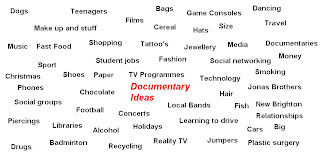
Thursday, 23 September 2010
Documentary Analysis - Seconds from Disaster
Type of Documentary
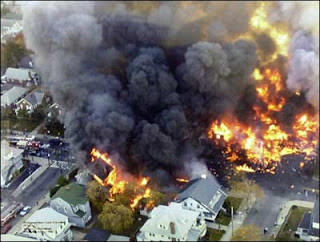
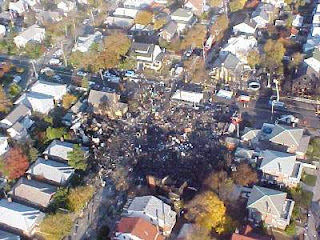
Mixed
Themes
Plane Crashes
Engine Failures
Narrative Structure
Non-Linear
Singe Strand
Close narrative structure
Camerawork
Interviews - CU or MCU, framed right or left of screen, eyeline 3rd way down the screen
Zoom in to terrified eyes
Handheld camera moving through new york
Zoom out of aircraft
Tracking shot of pilots
Low angle of pilots
Long shot down the aisle of aeroplane
Birds eye view of aeroplane
Panning shot
ECU of pilots eyes
CU of faces
Tracing across New York skyline
Tilt up from houses to the sky
Two shots
Mise-en-Scene
Aeroplanes
Firemen
Policemen
Air Hostesses
Sound
Voice over - Male, 40's, Clear delivery, serious and standard english
Aeroplane Engines
People's screams
Fast paced music which then slows down
Editing
Re-construction of a plan
Fast motion
Still images dissolve on and off screen
Cut
Archive Material
News footage
Radio messages
Newspaper headlines
Pilot training video
Graphics
Interviewee - white, bold font - name and job on a banner
Time countdown - white font
Time countdown - white font


Wednesday, 22 September 2010
Documentary Analysis - 9/11 After the Towers fell
Type of Documentary
Mixed
Themes
Terrorism
Fight for Survival
How peoples lives changed
Narrative Structure
Linear
Closed narrative structure
Single strand
Camerawork
Interviews - MCU, CU, framed right or left of screen, eyeline 3rd way down the screen
Birds eye view of Manhattan skyline
Tilt shot up the towers
Handheld camera - most used because people recorded it as it happened. i.e running away
Panning shot
Zoom out of buildings
Zoom into still images
Tracking shot of rubble
Wide shot of firefighters
POV shot
CU of firefighters badge
Long shot of empty streets filled with rubbish and debris
Two shot of two firefighters
Mise-en-scene
Fire engines
Firefighters
Police
Camera's
Background of interview: pale colour grey like smoke
Sound
Voice over - male, 40's clear delivery, calm and serious, standard english
Screams
Phonecalls
Eery music in the background
Radio messages
Editing
Writing dissolve off screen
Cut - different people running and screaming
Re-construction/dramatisation
Archive Material
Radio news
Voices off news shows
News footage of towers falling
Graphics
Translation of phone and radio calls - white and yellow font, sans serif
Interview - name and job or family member - sans serif, bold
Time, Date and location - white font, sans serif, bold
Mixed
Themes
Terrorism
Fight for Survival
How peoples lives changed
Narrative Structure
Linear
Closed narrative structure
Single strand
Camerawork
Interviews - MCU, CU, framed right or left of screen, eyeline 3rd way down the screen
Birds eye view of Manhattan skyline
Tilt shot up the towers
Handheld camera - most used because people recorded it as it happened. i.e running away
Panning shot
Zoom out of buildings
Zoom into still images
Tracking shot of rubble
Wide shot of firefighters
POV shot
CU of firefighters badge
Long shot of empty streets filled with rubbish and debris
Two shot of two firefighters
Mise-en-scene
Fire engines
Firefighters
Police
Camera's
Background of interview: pale colour grey like smoke
Sound
Voice over - male, 40's clear delivery, calm and serious, standard english
Screams
Phonecalls
Eery music in the background
Radio messages
Editing
Writing dissolve off screen
Cut - different people running and screaming
Re-construction/dramatisation
Archive Material
Radio news
Voices off news shows
News footage of towers falling
Graphics
Translation of phone and radio calls - white and yellow font, sans serif
Interview - name and job or family member - sans serif, bold
Time, Date and location - white font, sans serif, bold
Tuesday, 21 September 2010
TV Scheduling
The schedule for each day can be broken down into clear segments. How would you categorise these segments?
Breakfast programmes
Daytime TV
Childrens programmes
Family
Adult
Who are the target audience for these segments?
Breakfast - different for each channel
Daytime - women, elderly, unemployed, students
Children - children before school, infants who dont go to school
Family - for the whole family to watch
Adut - after the children have to gone to bed, adult programmes
What would you say are the most popular genres on television?
Soap operas
Gameshows
Talkshows
Films
Sit-Coms
Who is the target audiene of each terrestrial channel?
BBC1 - Mixed - caters for everybody
BBC2 - Educated audience, minority channel
ITV1 - Mixed - caters for everybody
Channel 4 - Young adults, educated
Channel 5 - Mised - caters for the whole population
Roughly, what percentage of each channels schedules is taken up with repeats?
BBC 1 - 8
BBC2 - 17
ITV1 - 3
Channel 4 - 12
Channel 5 - 10
Cheap to repeat programmes
Rare to get repeats in peak time
Which channels have more imported programmes in their schedules? Why do you think this might be?
Channel 4 and 5
Dont have as much money so its cheaper to import the programmes
What do you understand by the term 'the watershed' and where does this occur in the schedules?
9 0'clock
Shedding the childrens audience
Breakfast programmes
Daytime TV
Childrens programmes
Family
Adult
Who are the target audience for these segments?
Breakfast - different for each channel
Daytime - women, elderly, unemployed, students
Children - children before school, infants who dont go to school
Family - for the whole family to watch
Adut - after the children have to gone to bed, adult programmes
What would you say are the most popular genres on television?
Soap operas
Gameshows
Talkshows
Films
Sit-Coms
Who is the target audiene of each terrestrial channel?
BBC1 - Mixed - caters for everybody
BBC2 - Educated audience, minority channel
ITV1 - Mixed - caters for everybody
Channel 4 - Young adults, educated
Channel 5 - Mised - caters for the whole population
Roughly, what percentage of each channels schedules is taken up with repeats?
BBC 1 - 8
BBC2 - 17
ITV1 - 3
Channel 4 - 12
Channel 5 - 10
Cheap to repeat programmes
Rare to get repeats in peak time
Which channels have more imported programmes in their schedules? Why do you think this might be?
Channel 4 and 5
Dont have as much money so its cheaper to import the programmes
What do you understand by the term 'the watershed' and where does this occur in the schedules?
9 0'clock
Shedding the childrens audience
Sunday, 19 September 2010
Codes and Conventions of the Documentary Genre
Single strand narrative
Editing: Cut is most common edit - does not distract from what is going on, on screen
Voice over - holds the narrative together (glue) Variety of relevance
Relevant depending on topic, relevant age to the topic, standard english, calm and clear delivery
Creative and Varied Camerawork - conventional framing on interviews - sitting on a stable chair
Camera usually static on a tripod not hand held
Images (moving and still) - Camera movement when filmin still images
Archive material
If Chromakey is used it shouldn't detract from an interview
Relevant music - doesnt abtract ot interfeer with the interview
Graphics - Anchor person - time, place and relevance to programme 0 usually 2 lines
Editing: Cut is most common edit - does not distract from what is going on, on screen
Voice over - holds the narrative together (glue) Variety of relevance
Relevant depending on topic, relevant age to the topic, standard english, calm and clear delivery
Creative and Varied Camerawork - conventional framing on interviews - sitting on a stable chair
Camera usually static on a tripod not hand held
Images (moving and still) - Camera movement when filmin still images
Archive material
If Chromakey is used it shouldn't detract from an interview
Relevant music - doesnt abtract ot interfeer with the interview
Graphics - Anchor person - time, place and relevance to programme 0 usually 2 lines
Documentary Analysis - That Thing... Lara Croft
Type of Documentary
Mixed
Themes
Phenomonom of Lara Croft
Representation of Women
Power of the media influencing peoples thoughts of women
Narrative Structure
Closed narrative structure
Non-linear
Singe strand
Camerawork
Interviews - game footage behind - matches with the interview
- CU, ECU or MCU - eyeline 3rd way down screen - low angle
Zoom out of game being played on computer
Whip pans
Tracking shot of computers and the game
Barbie sequence - ECU
Mise-en-scene
Computers
Chromakey - game footage out of focus
Film clips
Front projection over the face of the interviewee
Sound
Madonna music in the background - An interviewee talked about madonna
Voice over - males, 20's, somebody who would play the game
Gun fire and music from the game
Voice of the character of Lara Croft
Editing
Cross cutting between game and film clips
Fast Motion in cyber cafe
Man on computer creen - tilted - inventer of the game
Archive Material
Lara Croft film clips
Game footage
Angelina Jolie interview
Nike advert
Newspapers and magazines
Websites
Graphics
White font - name and relevance to the game Lara Croft
Sans serif - all lover case
I have used one picture from the game and one from the film as that is what the documentary is about, how the game footage became so popular and was turned into a film.
Mixed
Themes
Phenomonom of Lara Croft
Representation of Women
Power of the media influencing peoples thoughts of women
Narrative Structure
Closed narrative structure
Non-linear
Singe strand
Camerawork
Interviews - game footage behind - matches with the interview
- CU, ECU or MCU - eyeline 3rd way down screen - low angle
Zoom out of game being played on computer
Whip pans
Tracking shot of computers and the game
Barbie sequence - ECU
Mise-en-scene
Computers
Chromakey - game footage out of focus
Film clips
Front projection over the face of the interviewee
Sound
Madonna music in the background - An interviewee talked about madonna
Voice over - males, 20's, somebody who would play the game
Gun fire and music from the game
Voice of the character of Lara Croft
Editing
Cross cutting between game and film clips
Fast Motion in cyber cafe
Man on computer creen - tilted - inventer of the game
Archive Material
Lara Croft film clips
Game footage
Angelina Jolie interview
Nike advert
Newspapers and magazines
Websites
Graphics
White font - name and relevance to the game Lara Croft
Sans serif - all lover case
I have used one picture from the game and one from the film as that is what the documentary is about, how the game footage became so popular and was turned into a film.
Documentary Analysis - The Music Biz: The Marketing of Meatloaf
Type of Documentary
Mixed
Themes
The marketing of music
Creatin of Image for band or singer
Power of the media to influence audience behaviour
Narrative structure
None-linear
Closed narrative structure
Single strand
Camerawork
Interviews - framed to left or right of screen, MCU or CU, eyeline 3rd way down screen (conventional)
Variety of camerawork: ECU of CD covers, maagazine front covers - different shot types, camera movement - pan across newspaper headline
High and low angle used
POV of someone walking into betting office
Handheld camera - all behind the scenes footage of the making of videos
Different meatloaf interviews - cut between
Filming the media, not being part of the media
Mise-en-Scene
Chromakey (blue or green screen)
Background is archive or actuality footage, related to what the interviewee is talking about
Sound
Voice over - Sarcastic, male, standard english, calm and clear delivery
Intertwined into the actuality footage
Meatloafs music - not just archive material of videos
Editing
Interviewees dissolve in and out
Crosscut between 3 interviews to tell the story (construct the narrative)
(all asked the same questions)
Video frozen behind the interviewee so audience doesnt get distracted
Filming behind the scenes footage and then crosscut to the final video
Slow motion
Archive Material
Magazine and CD covers
TV clips
Music videos
Chat shows
Brit and Grammy Awards
Newspaper headlines
Magazines
News footage
Undes to construct the mise-en-scene of interviews
Graphics
Intergrate moving images into magazine covers
The series logo - name of person on screen and their job - anchored their relevance to the matter
White, Serif font - right or left of screen - capitals and italics
I decided to add in the meatloaf music video because the documentary is all about how popular his record became, the making of the video and what they did to promote it.
Mixed
Themes
The marketing of music
Creatin of Image for band or singer
Power of the media to influence audience behaviour
Narrative structure
None-linear
Closed narrative structure
Single strand
Camerawork
Interviews - framed to left or right of screen, MCU or CU, eyeline 3rd way down screen (conventional)
Variety of camerawork: ECU of CD covers, maagazine front covers - different shot types, camera movement - pan across newspaper headline
High and low angle used
POV of someone walking into betting office
Handheld camera - all behind the scenes footage of the making of videos
Different meatloaf interviews - cut between
Filming the media, not being part of the media
Mise-en-Scene
Chromakey (blue or green screen)
Background is archive or actuality footage, related to what the interviewee is talking about
Sound
Voice over - Sarcastic, male, standard english, calm and clear delivery
Intertwined into the actuality footage
Meatloafs music - not just archive material of videos
Editing
Interviewees dissolve in and out
Crosscut between 3 interviews to tell the story (construct the narrative)
(all asked the same questions)
Video frozen behind the interviewee so audience doesnt get distracted
Filming behind the scenes footage and then crosscut to the final video
Slow motion
Archive Material
Magazine and CD covers
TV clips
Music videos
Chat shows
Brit and Grammy Awards
Newspaper headlines
Magazines
News footage
Undes to construct the mise-en-scene of interviews
Graphics
Intergrate moving images into magazine covers
The series logo - name of person on screen and their job - anchored their relevance to the matter
White, Serif font - right or left of screen - capitals and italics
I decided to add in the meatloaf music video because the documentary is all about how popular his record became, the making of the video and what they did to promote it.
Documentary Analysis - The Devil Made Me Do It: Public Enemy Number 1
Type of Documentary
Mixed
Themes
Devil Worship Vs Religion
Crime - Murder investigation
Youth of today
Power of the Media: can the media influence individuals behaviour?
Narrative Structure
Open narrative structure
Non-linear
Single strand
Camerawork
Interviews - MCU or CU, framed left or rigt of screen, eyeline is 1/3 of way down the screen
Low angle is used on Manson
Guy selling posters - handheld camera work (not pre-arranged)
Two shot of couple of couch
OTS POV of Inspector - CU of faces
Stock footage - churhces, religious iconography, angels, bell towers - low and high angle
Tracking shot of Manson walking through Rome
Zoom of still images
Crane shot of cemetary
Manson press conference - observation shots of news media - not part of journalism
Tilted frame from nuns point of view
Mise-en-Scene
Inspector - cap of officer appeared large with himself smaller behind it (low angle)
Isolated nun
Man visiting the graveyard
Lighting - on most of stock footage there very dark apart from one orange or blue glow
Manson one to one interviews - low angle (power)
Dark and half life (good or bad)
Sound
Voice over - narrator, male, standard english, very calm in delivery
Voice over if the glue that hold the narrative together
Translating voice over - same age, gender as person on screen
Manson music
Religious music
Soung effects used
Editing
Cut
Hours of stock footage edited down and matched what the boy being interviewed said about being bored and seeing men stood around
Priest - entire interview audio and now filmed him driving, he looks tired and quiet road ahead - dramatic effect
Killing the nun - door, heart beat speeds up and slows down then stops when dead. Hitting with rock and stabbing then dog barks, breathing and whispering then church bell singly strikes at death.
Juxtaposition - Manson fans, controversial footage - religious music
Archive Material
News footage - police invesitgation, nuns funeral, girls leaving court
American t.v - colombine massacre
Manson music video
Girls with Manson on their chest
Graphics
San serif white font - translating manson lyrics
- name as first line underneath relevance of person to topic
Left or right of screen - name bigger than job
Crusifix instead of letter T - dates and location
White text used to close the narrative of trial - credits being scrolled up screen
Tilting the audio being spoken

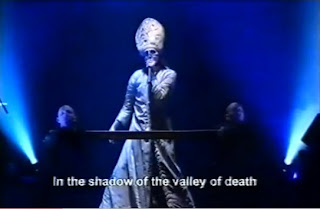
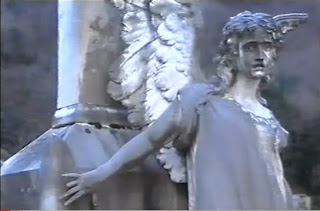
I have added in these pictures because it shows marilyn manson and when he dressed as the pope at one of his concerts, which is juxtaposition using religious connotations.
Mixed
Themes
Devil Worship Vs Religion
Crime - Murder investigation
Youth of today
Power of the Media: can the media influence individuals behaviour?
Narrative Structure
Open narrative structure
Non-linear
Single strand
Camerawork
Interviews - MCU or CU, framed left or rigt of screen, eyeline is 1/3 of way down the screen
Low angle is used on Manson
Guy selling posters - handheld camera work (not pre-arranged)
Two shot of couple of couch
OTS POV of Inspector - CU of faces
Stock footage - churhces, religious iconography, angels, bell towers - low and high angle
Tracking shot of Manson walking through Rome
Zoom of still images
Crane shot of cemetary
Manson press conference - observation shots of news media - not part of journalism
Tilted frame from nuns point of view
Mise-en-Scene
Inspector - cap of officer appeared large with himself smaller behind it (low angle)
Isolated nun
Man visiting the graveyard
Lighting - on most of stock footage there very dark apart from one orange or blue glow
Manson one to one interviews - low angle (power)
Dark and half life (good or bad)
Sound
Voice over - narrator, male, standard english, very calm in delivery
Voice over if the glue that hold the narrative together
Translating voice over - same age, gender as person on screen
Manson music
Religious music
Soung effects used
Editing
Cut
Hours of stock footage edited down and matched what the boy being interviewed said about being bored and seeing men stood around
Priest - entire interview audio and now filmed him driving, he looks tired and quiet road ahead - dramatic effect
Killing the nun - door, heart beat speeds up and slows down then stops when dead. Hitting with rock and stabbing then dog barks, breathing and whispering then church bell singly strikes at death.
Juxtaposition - Manson fans, controversial footage - religious music
Archive Material
News footage - police invesitgation, nuns funeral, girls leaving court
American t.v - colombine massacre
Manson music video
Girls with Manson on their chest
Graphics
San serif white font - translating manson lyrics
- name as first line underneath relevance of person to topic
Left or right of screen - name bigger than job
Crusifix instead of letter T - dates and location
White text used to close the narrative of trial - credits being scrolled up screen
Tilting the audio being spoken



I have added in these pictures because it shows marilyn manson and when he dressed as the pope at one of his concerts, which is juxtaposition using religious connotations.
Monday, 13 September 2010
Documentary
The purposeof the documentary is to document, that is to report, with evidence, something that has actually happened. It can show this by using actuality footage re-construction. It can use a narrator's voice over to anchor the meaning or rely on the participants themselves with perhaps the occasional interjection by the narrator.
"Actuality Footage" - 'real' footage of actual events
John Grierson - General Post Office Film Unit in 1930's
Defined documentary as: "the creative treatment of actuality" (or reality)
Features of Documentaries
John Corner of University of Liverpool said there are 5 central elements of a documentary.
-Observation
The programme makers pretend that the camera is unseen or ignored by people taking part in the events. The audience is preserved as the eye witness, witnessing events as they unfold.
-Interview
Most important aspect of a documentary. Documentaries rely heavily on the use of an interview.
-Dramatisation
All documentaries use a sense of drama through the observation element or dramatic re-construction
-Mise-en-Scene
Documentary makers carefully construct shots.
-Exposition
The line of argument in a documentary. It is what the documentary is "saying"
Different types of Documentary
-Fully Narrated
A voice over is used to convery the exposition
The voice over is used to make sense of the visuals and dominates their meaning
e.g natural history documentaries
-Fly on the Wall
Draws on the french film movement of cinema verite (truth)
The camera is unseen or ignored and simply records real events as they unfold
-Mixed
A combination of interview, observation, actuality and archive footage and narration to advance the narrative/argument
-Self-Reflexive
When the subject of the documentary acknowledges the presence of the camera and often speaks directly to the programme maker
-Docudrama
Re-enhancement of events
-Docusoap
Combination of documentary and soap opera
A group of central protagonists
Structure of Documentaries
-Narrative Structure
Open - loose ends which are not tied up at the end (questions left answered)
Closed - there is a definite conclusion to the narrative
Linear - follows chronological order
Non-Linear - things are not in times order
e.g flshback or flashfoward
Circular - Beginning is the same as the end
-Visuals
Television is a visual medium
The programme needs to be visually stimulating. Maintain the audiences interest
Arhive material, street scenes, open countryside, close up of faces = stock footage
Interviews
An interview can be held anywhere, but the mise-en-scene does effect the meaning
Vox Pop (Vox Populis) voice of the people
Grab passersby and ask the same question and edit them for the most interesting
Construction of Reality
Gatekeeping - The selection of rejections of information/content for inclusion in the media text
Editing Process - gatekeeping happens in a documentary, anchorage
The voiceover can also effect the meaning
Properganda - set out to influence the beliefs and opinions of the audience
"Actuality Footage" - 'real' footage of actual events
John Grierson - General Post Office Film Unit in 1930's
Defined documentary as: "the creative treatment of actuality" (or reality)
Features of Documentaries
John Corner of University of Liverpool said there are 5 central elements of a documentary.
-Observation
The programme makers pretend that the camera is unseen or ignored by people taking part in the events. The audience is preserved as the eye witness, witnessing events as they unfold.
-Interview
Most important aspect of a documentary. Documentaries rely heavily on the use of an interview.
-Dramatisation
All documentaries use a sense of drama through the observation element or dramatic re-construction
-Mise-en-Scene
Documentary makers carefully construct shots.
-Exposition
The line of argument in a documentary. It is what the documentary is "saying"
Different types of Documentary
-Fully Narrated
A voice over is used to convery the exposition
The voice over is used to make sense of the visuals and dominates their meaning
e.g natural history documentaries
-Fly on the Wall
Draws on the french film movement of cinema verite (truth)
The camera is unseen or ignored and simply records real events as they unfold
-Mixed
A combination of interview, observation, actuality and archive footage and narration to advance the narrative/argument
-Self-Reflexive
When the subject of the documentary acknowledges the presence of the camera and often speaks directly to the programme maker
-Docudrama
Re-enhancement of events
-Docusoap
Combination of documentary and soap opera
A group of central protagonists
Structure of Documentaries
-Narrative Structure
Open - loose ends which are not tied up at the end (questions left answered)
Closed - there is a definite conclusion to the narrative
Linear - follows chronological order
Non-Linear - things are not in times order
e.g flshback or flashfoward
Circular - Beginning is the same as the end
-Visuals
Television is a visual medium
The programme needs to be visually stimulating. Maintain the audiences interest
Arhive material, street scenes, open countryside, close up of faces = stock footage
Interviews
An interview can be held anywhere, but the mise-en-scene does effect the meaning
Vox Pop (Vox Populis) voice of the people
Grab passersby and ask the same question and edit them for the most interesting
Construction of Reality
Gatekeeping - The selection of rejections of information/content for inclusion in the media text
Editing Process - gatekeeping happens in a documentary, anchorage
The voiceover can also effect the meaning
Properganda - set out to influence the beliefs and opinions of the audience
Subscribe to:
Posts (Atom)



.jpg)

